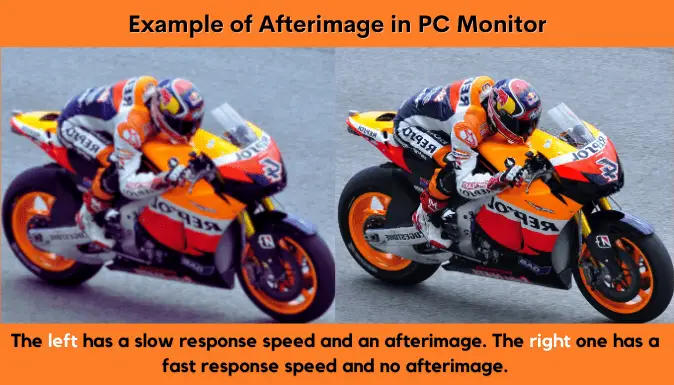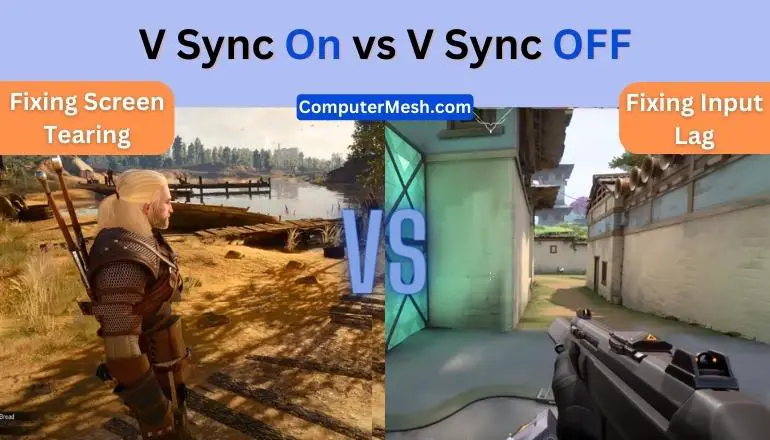Gaming Monitor vs Regular Monitor – Differences in Features.
If you’re in the market for a new monitor and running between gaming and regular monitors, you’ve landed at the right place. Here, I am comparing gaming monitors with regular monitor screens in an easy-to-understand manner.
Explore whether gaming monitors indeed hold the edge, their viability for tasks outside gaming, and the usefulness of using a gaming PC for work.
So whether you’re a gamer, a professional looking for an optimized work setup, or someone striking a balance between the two, this guide will provide some insights to help you make an informed decision.
Gaming vs Regular Monitor
What is a Gaming Monitor?
Gaming monitors are packed with features to play games comfortably. The refresh rate, color accuracy and response speed are superior to those of monitors for everyday use, and smooth image rendering is possible. For those who play fast-moving FPS and RPGs to enjoy beautiful image rendering, it is a must-have device.
Differences between Gaming Monitor and Regular Monitor
1. Less Input Delay
The gaming monitor has little input delay, and the image is reflected as soon as you operate the mouse.
In simple words, input lag is the time for mouse actions like clicking and scrolling to show up on your monitor. It’s the delay between you doing something and seeing it happen on screen.
Fast-paced action games such as FPS demand minimal input lag. You can’t kill your opponent the way you want if your input isn’t reflected the moment you click the mouse, even with a moment’s delay (where not only seconds but also milliseconds matter).
In fighting games like Street Fighter, even an input delay of less than a comma can be fatal. When playing games that require fast movements, I recommend using a gaming monitor with low input lag. Even for advanced FPS players, the winning rate will decrease if you use a non gaming monitor.
The delay is not only usually evident in the mouse but also in the keyboard keys, operating system response and graphics card’s execution.
2. High Refresh Rate
Gaming monitors support high refresh rates, unlike regular monitors. Everyday monitors typically have a maximum refresh rate of 60fps. Have you ever noticed afterimages or a jerky image while gaming on a regular monitor? That’s because of the low refresh rate.
In simple words, refresh rate is the number of times a monitor updates its image in one second, measured in hertz (Hz). A higher refresh rate means the monitor can display more frames per second, making the image look smoother.
What gives a gamer increased smoothness of the image? Obviously, the game feels more natural, which means that it is easier and more convenient to interact with it – the higher the smoothness of the picture, the easier it is to deceive the brain, which believes that it is not an electronic screen but real life.
On the other hand, gaming monitors have a high maximum refresh rate, and models that support up to 360fps are not uncommon. However, if you just play card and simulation games on your gaming PC, you probably don’t need a gaming monitor that supports more than 100fps.
If you want a gaming monitor, you must ensure the refresh rate is above 60 Hz. In this way, your eyes will quickly adapt to the game sequences you are doing. Fluidity is perceived almost naturally and effectively.
3. Reaction Speed is Fast (Response Time)
One of the appeals of gaming monitors is that they have a faster reaction speed than monitors for everyday use.
A normal monitor has a response speed of 10ms, but a gaming monitor has a fairly fast speed of 1ms called GTG or MRPT response time.
In simple words, the response speed is the time it takes for a panel to change colours. The lower the response speed, the faster the image changes. Therefore, gaming monitors are superior in terms of rapid transition between images.
If the response speed of the monitor is slow, it may cause image blurring or afterimages. In action games, a blurred image can often result in being disadvantaged due to afterimage attacks (aka ghosting). Also, using a fast reaction speed monitor can reduce the feeling of getting sick of the game screen.

4. V Sync Technology
Gaming monitors enjoy technologies such as FreeSync and G-Sync. These options are called refresh because they synchronize the monitor’s refresh with the FPS (Frames per second), which the graphics card is responsible for rendering. Vsync avoids screen tearing but can increase input lag.

FreeSync technology is free to implement, while G-Sync is proprietary to Nvidia, a leader in artificial intelligence computing. This allows for higher performance for gaming. Enabling DLSS or AMD’s FSR is another feature improving gaming video quality.
5. Flicker-Free Technology
Flicker-Free technology is one of the main features of gaming monitors, and it is responsible for eliminating flicker. This significantly reduces eye fatigue. Many products tend to say that they have this type of technology, although it is not entirely true. You need to ensure that it delivers what is promised on the display packaging.
6. Screen Panel
There are three types of panels used in monitors: TN panels, VA panels, and IPS panels. The TN panel is the cheapest monitor you can buy. VA panels come at a midrange price and offer high contrast ratios.
IPS panels are known for their wide viewing angles, excellent color accuracy, and low response time, but they tend to be the most expensive of all three types.
Because it can display beautiful images, it is ideal for those playing games focusing on graphics and RPGs with beautiful movies. On the other hand, regular monitors usually use TN panels for cost-effectiveness in design.
Note: All High Performance Monitors are Expensive
A gaming monitor with high functionality will also cost more to purchase. For example, it is not uncommon for 4K-compatible gaming monitors to cost more than 400$.
Recently, relatively cheap gaming monitors have been released, still they are expensive than regular monitors. When purchasing a gaming monitor, it’s a good idea to decide in advance which features to prioritize.
Can you use Gaming Monitor for Work?
Gaming monitors aren’t just for gameplay. Using a gaming monitor for work can be a good idea in some cases, but it depends on your needs and preferences.
Although gaming monitors are designed to provide fast and smooth visuals, which is necessary for gaming, where quick reactions and precise movements are crucial. These features are optional for work, especially tasks like office work, content creation, or programming. However, there are some advantages to using a gaming monitor for work:
- High resolution and good color accuracy for detailed visual tasks like graphic design or video editing.
- High refresh rates can make scrolling through documents and web pages appear smoother.
- Gaming monitors with multiple input options, like HDMI and DisplayPort, enables you to connect multiple monitor like dual display with cable or even triple if you need.
However, there are also a few potential drawbacks to using a gaming monitor for work:
- Cost: Gaming monitors are expensive than regular monitors. You may end up paying for gaming-specific features you don’t need for work tasks.
- Overkill: The high refresh rates and response times might not be necessary for most work tasks, so if that won’t benefit you much, you could be spending money on features.
Gaming Monitor is for PC Gaming
Gaming monitors are specifically designed for gaming, offering a whole new level of visual experience. If you’ve been playing games on a regular monitor, you’ll be amazed at the difference a gaming monitor can make in image rendering.

They are especially crucial for genres like FPS/TPS and fighting games that demand quick movements. I personally didn’t expect much of a difference until I tried using a gaming on Windows and 11 myself before, but using a gaming monitor to spend many hours in front of it makes it so easier to play!
But for those who do not have a powerful computer, you should first tighten up the power of the gaming hardware – the GPU, CPU, RAM else PC bottleneck occurs.
Conclusion
Gaming monitors are not only more expensive due to a mere marketing strategy, but also offer features that are necessary for a player to have excellent performance in front of the screen.
The regular monitor lacks the necessary elements for the quality of the competitions, such as: refresh rates lower than 60Hz, non-ergonomic designs with thin frames, technologies to avoid visual fatigue, low resolution, among others. Gaming monitors are high-end and contain ports such as HDMI or DisplayPort but not old ones like DVI or VGA many cards.
These are some of the differences that separate a gaming monitor from a normal screen. It all depends on your needs. In addition, the activities that you will carry out with the monitor influence.
FAQs
Can you use Gaming Monitor as Home Television?
By preparing a TV tuner, you can use the gaming monitor as a TV replacement. Recommended for those who want to install both a TV and a gaming monitor but don’t have the space. However, not all gaming monitors have built-in TV tuners or speakers, so check before purchasing.
Is a regular monitor good for PS5?
A gaming monitor is also recommended for those who play games on PS5 and PS4. Gaming monitors are not only specialized for games but also equipped with eye-friendly functions such as blue light reduction. Gaming monitors are better than regular ones for long gamers. Also, since PS5 supports up to 120fps, you can fully bring out the performance of PS5 by using a gaming monitor.
When should I get a gaming monitor?
If you’re building a top-of-the-line gaming PC and have the budget to purchase one of these gaming monitors, go for this option. But if your computer is not for gaming and has no powerful specs, why you need a gaming monitor is not entirely clear.
Is there any condition for getting a high FPS gaming monitor?
A necessary condition is a powerful graphic card but not iGPU like Intel UHD, Iris, AMD Vega, the FPS of which is at least the hertz of the monitor. Otherwise, it will not be possible to achieve a smooth dynamic picture.
Do gaming monitors come with a game mode?
Some gaming monitors come with a game mode. The functions installed by the manufacturer differ, such as “function to improve visibility in the dark”, “function to optimize images for games”, and “function to reduce backlight and reduce eye fatigue”. Check it out. It tends to be installed in expensive monitors.
